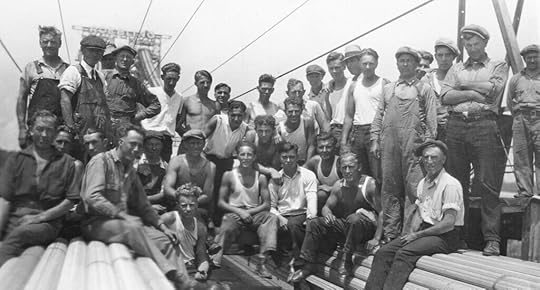Archiving a Way
 These are the men who strung and assembled the cables that hold up the George Washington Bridge roadway. After this was shot, on July 25, 1929, the cable bundles were compressed, sheathed, and draped with suspension cables to the new roadway that would be built below. The photo is from the collection of Allen H. Searls, the gap-toothed guy with a big grin at the center of the photo. He was 21 at the time.
These are the men who strung and assembled the cables that hold up the George Washington Bridge roadway. After this was shot, on July 25, 1929, the cable bundles were compressed, sheathed, and draped with suspension cables to the new roadway that would be built below. The photo is from the collection of Allen H. Searls, the gap-toothed guy with a big grin at the center of the photo. He was 21 at the time.My father, Allen H. Searls, was an archivist. Not a formal one, but good in the vernacular, at least when it came to one of the most consequential things he did in his life: helping build the George Washington Bridge. He did this by photographing his work and fellow workers. He shot with a Kodak camera, and then developed and printed each shot, and assembled them into an album that survives to this day. All the shots in this collection are from that album. I’ve archived them in my Flickr site focused on infrastructure. I have also Creative Commons licensed them to require only attribution. (Though I’d rather people credit Allen H. Searls than his son.)
Only two of the photos are dated. One is July 25, 1929, when workers and families celebrated the completion of the cable stringing operation. The other is July 25, 1930, presumably when the roadway was completed. I was able to piece together the significance of these dates, and guess at the date ranges of other pictures, by doing a deep dive into the New York Times archive (where I found that these guys were called “bridgemen,” and by reading my father’s copy of the Roebling Cable company’s book about how the bridge’s cables were made and put in place.
As we know now, almost too well, we live in an Age of AI, when the entire corpus of the Internet, and God only knows what else, has been ingested into large language models that are trained and programmed to answer questions about what they “know” (even though they don’t, really). Meanwhile what do we, as human beings, actually know? Or, better yet, where can we find what we need or want to know? Libraries of the physical kind are necessary but insufficient when our instruments of inquiry are entirely electronic. The World Wide Web has turned into the World Wide Whiteboard.
We need electronic archives. Simple as that.
We all know (and, I hope, appreciate) the Internet Archive. I was going to give my father’s copy of the Roebling book to the Archive for scanning, but discovered it’s already there! That made the book easy to read (here on this flat screen), and saved my own fragile copy from further damage.
A heroic example of one person’s work to save the whole corpus of literature on broadcasting is David Gleason’s World Radio History site, without which much knowledge of broadcasting history would be lost.
On the contemporary front, Dave Askins‘ work toward online local news chronicles may prove essential if we don’t want to see current and future news disappear down the same holes into which too many past publications’ work has fallen (or remains alive but trapped behind paywalls).
For more on where this might go, see my Archives as Commons post. I’ll be talking about this, I hope, at the upcoming WoW Conference and DWeb Camp.
Doc Searls's Blog
- Doc Searls's profile
- 11 followers



